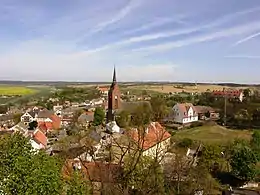Cedynia
Cedynia (pronounced Tse-dinya [t͡sɛˈdɨɲa]; German: Zehden, Latin: Cedene) is a small historic town in Poland, and the administrative seat of Gmina Cedynia in Gryfino County, West Pomeranian Voivodeship. It is situated close to the Oder river and the border with Germany. The town is known for the 972 Battle of Cedynia, the first historically recorded battle of Poland.
Cedynia | |
|---|---|
 | |
 Coat of arms | |
 Cedynia  Cedynia | |
| Coordinates: 52°53′N 14°12′E | |
| Country | |
| Voivodeship | West Pomeranian |
| County | Gryfino |
| Gmina | Cedynia |
| Established | 9th century |
| Town rights | 1299 |
| Government | |
| • Mayor | Adam Andrzej Zarzycki |
| Area | |
| • Total | 1.67 km2 (0.64 sq mi) |
| Population (2006) | |
| • Total | 1,653 |
| • Density | 990/km2 (2,600/sq mi) |
| Time zone | UTC+1 (CET) |
| • Summer (DST) | UTC+2 (CEST) |
| Postal code | 74-520 |
| Area code(s) | +48 91 |
| Car plates | ZGR |
| Website | http://www.cedynia.pl |
Geography
Cedynia lies in an area that formed part of historic regions of Pomerania and Greater Poland, before later being part of Neumark. It is situated close to the Oder river, which since 1945 forms the Polish–German border; it thereby is the westernmost settlement in Poland (neighbouring Osinów Dolny lies 6 kilometres (3.7 mi) even further to the west, right on the German border, but is classified as a village). A road border crossing leads to the German town of Bad Freienwalde, Brandenburg in the southwest.
The town gives its name to an extended protected area known as Cedynia Landscape Park.
History
Largely depopulated during the Migration Period, the first Slavic settlement came into existence in the 8th century,[1] when a gród fortification was erected in the area. According to the Cedynia website, the "Name of city appears in documents under oldest written records already in the year 972 as Cidini, in 1187 as Zedin and Cedene, in 1240 as Ceden. "
.JPG.webp)
On 24 June 972, the first historically recorded battle of the Polan dukes, the Battle of Cedynia, took place at this location: the Piast duke Mieszko I of Poland and his brother Czcibor defeated the forces of the Saxon count Odo I, who then ruled as a margrave in the Saxon Eastern March (Lusatia). Information about this battle is found both in the chronicles by Thietmar of Merseburg and in the Gesta principum Polonorum by Gallus Anonymus. After Emperor Otto II intervened, a peace was reached at the Imperial Diet in Quedlinburg the next year. After his victory, Mieszko gained access for the first time to the Oder river running north to the Baltic Sea and to some parts of the land later called Pomerania.
Under Mieszko's son Bolesław the name Poland was used for the first time. The Battle of Cedynia was the first of Mieszko and Bolesław's numerous battles that they took up in their conquest attempts in the Polabian border territories soon after they received positions as dukes, mainly in the German–Polish War that lasted from 1002 until the 1018 Peace of Bautzen. In the early 12th century, Bolesław III Wrymouth once again was able to conquer the Pomeranian territories in the north; nevertheless, by 1227 the newly established Duchy of Pomerania had become an integral part of the Holy Roman Empire. Cedynia, together with Santok and Drezdenko remained the seat of a (Greater) Polish castellany on the Pomeranian border in the 12th and 13th centuries.

With adjacent Lubusz Land in the south, the town became a part of the Neumark acquisitions of the Ascanian margraves John I and of Otto III of Brandenburg in 1248/52. In 1278 the Cistercians from nearby Chorin Abbey erected a nunnery there, which was secularised in 1555 and finally dissolved in 1611, after the Reformation. In 1373 the town became part of the Lands of the Bohemian (Czech) Crown, ruled by the Luxembourg dynasty. In 1402, the Luxembourgs reached an agreement with Poland, upon which Poland was to buy and re-incorporate the region, but eventually the Luxembourgs sold it to the Teutonic Order. In 1454 the Teutonic Knights sold the town to the Margraviate of Brandenburg in order to raise funds for war with Poland.
During the Thirty Years' War the town was destroyed by Swedes, whose King Gustavus Adolphus took quarter in the former nunnery. Town and nunnery were badly destroyed in subsequent battles. In 1641 the Hohenzollern elector Frederick William of Brandenburg had the western wing of the nunnery's ruin rebuilt as a Baroque hunting lodge.
In 1701 the town - like all of Brandenburg - became a part of the Kingdom of Prussia. In 1815 Zehden became part of the Königsberg district within the Brandenburgian Frankfurt Region. In 1871, with all of Prussia, the town became part of the German Empire.

In the last days of World War II, Zehden was conquered by Red Army forces during the Vistula-Oder offensive. After the war, the town along with the German former eastern territories, including the Brandenburg Neumark region, was handed over to the Republic of Poland according to the 1945 Potsdam Agreement and the remaining German population was expelled. A monument to the 972 Battle of Cedynia was erected in the town on the occasion of the millennial anniversary in 1972.
Culture
A local museum (Muzeum Regionalne w Cedyni) is located in central Cedynia.
References
- "Miasto i Gmina Cedynia". Archived from the original on 2010-03-27. Retrieved 2006-12-08.
External links
| Wikimedia Commons has media related to Cedynia. |
- Official town website
- Polish site with early spellings of town name
- Zehden is 30 miles N/E of Berlin on 1882 map of Brandenburg
- Jewish Community in Cedynia on Virtual Shtetl